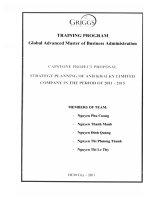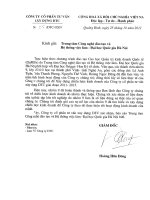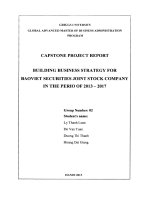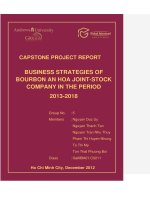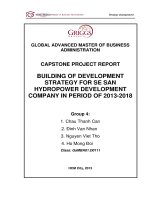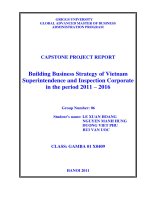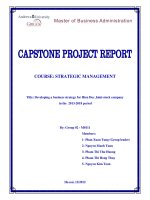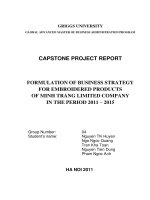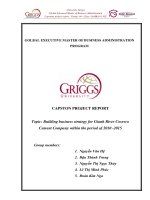Business strategies of Bourbon An Hoa joint-stock company in the period 2013-2018
Bạn đang xem bản rút gọn của tài liệu. Xem và tải ngay bản đầy đủ của tài liệu tại đây (2.12 MB, 114 trang )
i
CAPSTONE PROJECT REPORT
BUSINESS STRATEGIES OF
BOURBON AN HOA JOINT-STOCK
COMPANY IN THE PERIOD
2013-2018
Group No. : 5
Members : Nguyen Duc Uy
Nguyen Thanh Tan
Nguyen Tran Nhu Thuy
Pham Thi Huyen Nhung
To Thi My
Ton That Phuong Boi
Class : GaMBA01.C0211
Ho Chi Minh City, December 2012
i
GRIGGS UNIVERSITY
GLOBAL ADVANCED MASTER OF BUSINESS ADMINISTRATION PROGRAM
CAPSTONE PROJECT REPORT
BUSINESS STRATEGIES OF BOURBON AN HOA
JOINT-STOCK COMPANY IN THE PERIOD
2013-2018
Group No. : 5
Members : Nguyen Duc Uy
Nguyen Thanh Tan
Nguyen Tran Nhu Thuy
Pham Thi Huyen Nhung
To Thi My
Ton That Phuong Boi
Class : GaMBA01.C0211
Ho Chi Minh City, December 2012
Hochiminh City
05/2012
ii
ACKNOWLEDGEMENT
We would like to express our heartfelt thanks to the valued professors of Griggs
University for their support in providing the information of management strategy,
useful guidance and feedback so that we can complete this dissertation.
I would like to express my heartfelt thanks to the Board of Directors of Bourbon
An Hoa Joint Stock Company who has created favorable conditions for us to easily
access and do research on the internal information as well as has shared about both
of the advantages and difficulties of the company.
i
ii
TABLE OF CONTENTS
ACKNOWLEDGEMENT iii
TABLE OF CONTENTS ii
LIST OF TABLES vii
LIST OF FIGURES, GRAPS vii
INTRODUCTION 1
1. Background of the study 1
2. Objectives and tasks of the topic 1
3. Research method 2
4. The significance of the topic 3
CHAPTER 1: 4
THEORETICAL FRAMEWORK OF BUSINESS STRATEGY 4
1. Concept of business strategy 4
1.1.1 Definition 4
1.1.2 Role: 5
1.1.3 Categories 5
1.1.3.1 Corporate level strategy 6
1.1.3.2 Business unit level strategy 7
1.1.3.3 Functional level strategy 8
1.2 Strategic planning process 8
1.2.1 Environmental scan 8
1.2.1.1 external environmental scan 9
a) Macro-environment (PEST) 9
b) Microenvironment 9
c))External factor evaluation 10
d) Competitive matrix 11
1.2.1.2 Internal factor evaluation 11
a) Resource analysis 11
iii
b) Analysis of mission’s adaptability and environment objective 12
c) Analysis of specialized divisions’ operation in the organization 13
d) Internal factor evaluation (IFE) 13
1.3 Strategy analysis 14
1.3.1 Strength- weakness, opportunity- threat matrix (SWOT) 14
1.3.2 Strategic Position & Action Evaluation matrix (SPACE) 16
1.3.3 Internal-external matrix (IE) 17
1.3.4 Grand strategy matrix 18
1.4 Strategy choice 19
CHAPTER 2: 22
ANALYSIS OF BUSINESS ENVIRONMENT AND CURRENT SITUATION OF
BOURBON AN HOA CORPORATION 22
2.1 Introduction 22
2.1.1 General information 22
2.1.2 History of establishment and development 22
2.1.3 Development orientation 23
2.1.4 Structure of organization 24
2.2 External environment analysis 24
2.2.1 Macroenvironment analysis 24
2.2.1.1 Economy 25
a) World economy situation 25
b) National economy situation 25
2.2.1.2 Politics 28
2.2.1.3 Society 30
2.2.1.4 Technology 31
2.2.2 Microenvironment analysis 31
2.2.2.1 Micheal Porter model 31
a) Competitor 31
b) Customer: 32
iv
d) New entrants 32
e) Substitue 33
2.2.2.2 Analysis of Southeast economic region 33
a) Brief information of Southeast economic region 33
b) Ealuation of competitive advantages of Southeast region 36
c) Evaluation of competitive competency of Southeast region 37
d) Analysis of the competition among Industrial Zones In South East
region 40
2.2.2.3 Tay Ninh province’s analysis 41
a) Tay Ninh in General 41
b) Analysis of the attraction of foreign direct investment 41
2.2.3 External factor evaluation matrix (EFE) 44
2.3.4 Competitive matrix 46
2.3 Analysis of internal environment 47
2.3.1 Analysis of business operation in the period of 2009-2012 47
2.3.1.1 Human resource 47
2.3.1.2 Investment in the industrial zone’s infrastructure 47
2.3.1.3 Result of business operation 48
2.3.1.4 Marketing operation 49
2.3.2 Analysis of company’s strategies in the period of 2009-2012 50
2.3.2.1 Core competitive advantages 50
2.3.2.2 Business strategies 51
2.3.3 Internal factor evaluation matrix (IFE) 52
CHAPTER 3: 54
BUILDING THE BUSINESS STRATEGIES OF BOURBON AN HOA JOINT
STOCK COMPANY IN THE PERIOD OF 2013-2018 54
3.1 Analysis of strategy models 54
3.1.1 SWOT matrix 54
3.1.2 Strategic Position & Action Evaluation matrix (SPACE) 56
v
3.1.3 Internal – External matrix (IE) 57
3.1.4 Grand strategy matrix 58
3.2 Building the business strategies of Bourbon An Hoa joint stock company in the
period of 2013-2018 59
3.2.1 Vision, mission and core value 59
3.2.2 Business objectives 60
3.2.2.1 Short-term objectives (2013-2015) 60
3.2.2.2 Long-term objectives (2013-2018) 60
3.2.3 Business strategies 60
3.2.4 Solutions of business strategy implementation 8379
3.2.5 Control and evaluation of strategies 9692
CONCLUSION 9995
REFERENCE 10197
APPENDIX 10298
vii
LIST OF TABLES
Table 1.1 - Matrix EFE 11
Table 1.2 - Competitive matrix 11
Table 1.3 - Matrix IFE 14
Table 1.4 - SWOT matrix 15
Table 1.8 - QSPM matrix 20
Table 2.7 – Table of PCI of Southeast provinces 38
Table 2.8 – Criteria of CPI of Southeast provinces 39
Table 2.10 – FDI inflow to Southeast region in 2010, 2011, 2012 42
Table 2.11 – Top nations investing in Vietnam in 2010, 2011, 2012) 42
Table 2.12 – Industries attracting foreign direct investment in Vietnam in 2010 and
2011 43
LIST OF FIGURES, GRAPS
Figure 1.5 - SPACE matrix 16
Figure 1.6 - Matrix IE 17
Figure 1.7 - Grand strategy matrix 18
Figure 2.1 - Structure of organization of Bourbon An Hoa Joint Stock Company 24
Figure 2.2 – FDI attraction in the period 2000-2012 27
Figure 2.3 – Japanese FDI inflow into Vietnam 28
Picture 2.4 - Statistics of economic regions’ areas 35
Figure 2.5 - Statistics of economic regions’ population 35
Figure 2.6 - Statistics of FDI in 2011 36
Figure 2.9 - Graph of industrial parks and export processing zones allocation 40
Figure 3.1 - SPACE Matrix of Bourbon An Hoa 5756
Figure 3.2 - IE Matrix 57
Figure 3.3 - Grand strategy matrix 58
1
INTRODUCTION
1. Background of the study
Vietnam is at the stage of opening and integration into the global economy. This is
not only an opportunity but also a challenge for Vietnamese enterprises, which are
considered as small scale, weak management and poor foreign market expertise.
Fierce competition in the real market requires these enterprises to adjust in order to
improve their competencies, to maintain their domestic market share as well as to
expand to global market.
There are a variety of measures in order to competitive competency of enterprises.
Nevertheless, in my opinion, the most essential point is that enterprises must change
their business styles from experience-based and subjective-thought one to strategic
one.
Clear strategies will help enterprises run and manage their businesses easier and
more efficiently. The whole Board of Management and employees understand their
tasks and objectives thoroughly that makes them more confident, proactive and
responsible in their work. Strategic management will help the company’s leaders
make right business decisions based on the analysis and the generalization of
internal and external information; or based on the inside and outside changes, Board
of Management will plan business strategies as well as give on time adjustments to
adapt to business environment’s metamorphosis.
Considering the urgency and necessity of this issue, we decide to choose our thesis
topic as "Building the business strategy for Bourbon An Hoa Joint Stock Company
in the period of 2013-2018 ". Through this topic, we would like to apply theories
and modern analytical models to strategic planning and management of Bourbon
An Hoa Joint Stock Company.
2. Objectives and tasks of the topic
Objectives
2
- To analyse the external business environment factors influencing company’s
business sector, then to find out company business field’s opportunities and threats
in order to build the matrix evaluating external factors.
-To analyse internal factors of the company, then to find out strengths and
weaknesses in order to build the matrix evaluating the internal factors.
- To apply modern analytical models in business in oder to build selectively feasible
strategies. Based on these model analysis results, the company will make decisions
of suitable strategies for execution.
Tasks
-To support Bour bon An Hoa company to build business strategy in the period of
2013-2018 based on quantiative analysis of internal and external information
through models
- To make the company realize the benefits and efficiencies of applying analysis
models to plan strategies in comparison with traditional method which is experience
and personal feeling based.
3. Research method
Subject and Scope of Research: The research is based on the business
information of company’s field, competitors and internal environment of Bourbon
AnHoa company
Research period: from 1
st
November 2012 to 30
th
December 2012
Data collection method
-Internal information: making reference to the company’s history of establishment
and development as well as its business operation report, in-depth interviews with
the Board of Management.
-External information: collecting reports as well as specialized articles from
electronic sources of governmental bodies or independent organizations
Research method of the topic
- Mmethod of dialectical materialism
- Mmethod of description
3
- M method of statistics and forecast
- Mmethod of comparison and collation
- Mmethod of analysis and generalization
- Method of in-depth interview with experts
4. The significance of the topic
This thesis with the topic "Building the business strategy for Bourbon An Hoa Joint
Stock Company in the period of 2013-2018" is going to become an important
reference source for the Board of Management planning future business strategies
We hope that our study will provide much useful information contributing to the
company’s success.
4
CHAPTER 1:
THEORETICAL FRAMEWORK OF BUSINESS STRATEGY
In order to build business strategy for Bourbon An Hoa company, we have
studied the theoretical basis of "Strategy & Business Policy" compiled by Associate
& Dr. Diep Nguyen Thi Lien and MA Pham Van Nam and published in 2006. Some
of the content about strategy building has been studied and summarized as follows:
1. Concept of business strategy
1.1.1 Definition
Nowadays, there are a lot of different concepts of strategic management. However,
it could be generalized into three most popular approaches as follows:
Iin term of environment
“Strategic management is a process for integrating internal abilities of the
organization with external opportunities and threats”
Iin term of objective and method
“Strategic management is a set of managing decisions and actions which decide
company’s long term achievements”
Iin term of actions
“Strategic management is to examine present and future environments, to create
organization’s missions, to make and execute decisions as well as to control these
executions in order to achieve present and future goals”
Based on the above approaches, we suppose the definition of strategic
management as follows:
“Strategic management is the process of studying present and future environments,
planning organization’s objectives; making and executing decisions as well as
controlling these executions in order to achieving present and future objectives for
enhancing company’s power”
5
1.1.2 Role:
Because there are a variety of complex variables affecting, it’s almost impossible
to find out the direct relationship between strategic management and company’s
profit. Therefore, isolating and examining one variable’s impact on company’s
profit is unworkable. Nevertheless, indirect contribution to company’s profit
through taking advantages of opportunities and gaining the upper hand in
competition of strategic management is undeniable.
Bbenefits of strategic management
- Clarifying objectives and directions of organizations. Hence, the managers need
to consider and define which way they should follow and when they achieve a
certain position.
- Strategic management requires the managers to analyse and forecast environment
conditions in short term and long term; thus to be able of grasping opportunities
better and taking full advantage of these opportunities as well as reducing negative
risks.
- Making company decisions closely based on relevant environment conditions
- Reducing severe risks and increasing company’s competency in exploiting
available opportunities.
Disadvantages of strategic management
- It takes much time and effort
- It could be considered as stiffly built in form of written documents.
- There may be big mistakes in long term forecast
- Some companies still attaches much importance into planning without paying
enough attention to execution that causes doubts of strategic management’s
usefulness for some managers
1.1.3 Categories
Strategic management is going to be applied at different levels in an organization
that can be categorized in to three basic levels as follows:
6
1.1.3.1 Corporate level strategy
It’s a typical pattern for company’s decisions that defines objectives and goals
as well as business operation activities in order to establish foundation policies
and plans for the company.
Popular corporate level strategies
Concentrated growth strategy
Strategy of market penetration: Increasing current market share by more
audacious marketing efforts
Strategy of market development: gaining business growth by entering new
market with current products
Strategy of new product development: gaining business growth by
developing current market share with new products
Integration strategy
Backward integration strategy: gaining business growth by acquiring the
control or possession of its supplies
Forward integration strategy : gaining business growth by acquiring the
possession or control of the direct distribution of its products or eliminating the
middle man to approach closer to the final customer.
Diversification strategy
Concentric diversification: gaining business growth by acquiring or
developing new products or services (closely related to its current products)
to enter one or more new markets.
Horizontal diversification: gaining business growth by acquiring or
developing new products or services that are different from its core business or
technology, but which may appeal to its current market
Heterogeneous (conglomerate) diversification: moving to new products or
services that have no technological or commercial relation with current
products, but which may appeal to new groups of customers or new market.
Retrenchment strategy
Formatted: No underline, Font color: Auto
Formatted: No underline
Formatted: No underline, Font color: Auto
Formatted: No underline
Formatted: No underline, Font color: Auto
Formatted: No underline
Formatted: No underline, Font color: Auto
7
Turnaround: a short term or temporary strategy eradicating organization’ s
inefficiency by cutting operation costs, improving productivity, cutting labour
cost, eliminating secondary products or facilities
Divestment strategy: used by businesses when they downsize the scope of
their business activities by selling or eliminating a portion of business in order
to acquire a long term change in their business operation scope.
Harvest strategy: Maximizing the cashflow in a short time regardless of long
term consequence
Liquidation strategy: closing down the entire firm and selling its assets in
accordance with court’s decrees. It is considered the most extreme and the last
resort.
Reasonable strategies: the company can combine many strategies in order to
achieve its business objectives such as penetrating the market, developing the
products, backward integrating, horizontal diversification or divestment.
In addition, the company can use other strategies by external concentration
such as consolidation, acquisition and joint venture.
1.1.3.2 Business unit level strategy
Determining the selection of specific product or market for each business activity
within the company, and how the company will compete with other competitors in
the same industry. Business unit level strategies of the business determine how each
business unit makes efforts to achieve its objective in contribution to the corporate
objective. If the company is in a single industry, the business unit level strategy can
be considered as corporate level strategy or the corporate level strategy can also be
applied for business unit level strategy.
Popular business unit level strategies
Competition strategy in Michael E.Porter’s perspective
Cost leadership strategy: building competitive advantage by setting lower
price than competitors’ one in the same industry in order to attract price-
conscious customers and to gain big market share.
8
Differentiation strategy: creating distinguished products and marketing
programmes from competitors’ ones in order to win the leading position
Integrated strategy of cost leadership differentiation of outputs: providing
customers with superior value by satisfying customer’s desire such as quality,
service, outstanding features, performance results use with the most reasonable
price.
Strategies based on market dominance
Strategies for leaders: Expand the total market; Protect the existing market
share; expand the existing market share or defensive strategy
Strategies for challengers: frontal attack; flank attack; encirclement attack;
bypass attack and guerrilla warfare
Strategies for followers: complete imitation, imitation of some core
competencies of competitor’s integrated marketing together with some
differentiation, imitation with improvement to adapt to the market
Strategies for nicher: focusing on a specific market segment, focusing on a
specific stage in the manufacturing and distribution process, focusing on a
selling region etc.
1.1.3.3 Functional level strategy
Focusing on improving the effectiveness of a business at an operational level.
In order to create products with superior values, functional level strategies in
marketing, finance, purchasing, and R&D involve the development and
coordination of resources through which business unit level strategies can be
executed efficiently.
1.2 Strategic planning process
1.2.1 Environmental scan
Environmental factors have a huge impact because they affect the whole
subsequent steps of the strategic management process. Chosen strategies must
be planned on the basis of the studied environmental conditions.
9
1.2.1.1 external environmental scan
a) Macro-environment (PEST)
Researchers of business strategic management usually choose the following
macroenvironmental factors to do research:
-Economic factor: has huge impact on enterprises such as financial and
monetary policies, periods of economic circle, interest rates, balance of
payments
-Political factor: the legal system and government policies also affect the
operation of the business (hiring, lending, security, pricing, advertising,
environmental protection, etc.).
-Social factor: usually affects business gradually and unrecognizably and
needs to be forecasted in order for business to plan suitable strategies.
However, there are also fast impacts such as consuming trend or
entertaining trend
- Technological factors: together with the strong development of science
and technology, nowadays most businesses can take advantage of
technology transfer but also bear the risk of technological competition with
ones possessing more advanced technology. The key point is that business
should pay attention to the life cycle of technology and its effect once
applied into business’s operation.
b) Microenvironment
The micro environment includes the whole factors within the industry that
are the external factors of business, deciding the characteristic and level of
competition. There are five basic factors that are competitor, consumer,
supplier, new entrant and substitute product.
- Competitor: analysis based on criteria such as future objectives, current
strategies, potential and so forth
- Consumer: is a company’s stakeholder and loyal customer is a big
advantage for the company. So, it’s necessary for the company to comprise
10
customer data source in order to find out the consuming trend. Customers
have the bargaining power that requires companies to segment their current
and future customers for better demand satisfaction.
- Supplier: Suppliers of raw materials, components, labor, and services
(such as expertise) to the firm can be a source of power over the firm.
- New entrant: can have bad impact on company’s profit. They are also
potential competitors when they buy out or acquire other companies in the
industry in order to gain the market share.
- Substitute product: is to the detriment with the industry’s profit
c))External factor evaluation
External factor evaluation help the strategic planners summarize and
evaluate the above information. There are five steps to build the matrix:
-Listing the external factors playing the important role with opportunities
and challenges inclusively
-Assign a weight from 0,0 (not important) to 1,0 (very important) to each
factor. The total value of all weights together should equal 1
-Assign a rating to each factor from 1 to 4. Rating indicates how effective
the firm’s current strategies respond to the factor. 1 = the response is poor.
2 = the response is below average. 3 = above average. 4 = superior. Weights
are industry-specific. Ratings are company-specific.
- Multiply each factor weight with its rating. This will calculate the
weighted score for each factor.
- Add all weighted scores for each factor. This will calculate the total
weighted score for the company.
11
Table 1.1 - Matrix EFE
External factors
weight
rating
weighted score
1.
2.
3.
…
total weighted score
d) Competitive matrix
It is the expansion of EFE in order to identify the major competitors
together with their advantages and disadvantages. Ratings and weights are
calculated similarly to EFE matrix.
Table 1.2 - Competitive matrix
Success factor
Weight
Company A
Company B
Company C
rank
Weighted
score
rank
Weighted
score
rank
Weighted
score
1.
2.
3.
…
Total weighted
score
1.2.1.2 Internal factor evaluation
a) Resource analysis
Human resource: the first factor needs to be analysed
- High-level managers: there are skills such as mentality, human,
specialized and team work ones necessary to be considered carefully in
different level. Their contribution to the organization and professional
etiquette are also put in consideration.
12
-Executives: analysis based on professional competency, professional
etiquette and achievement in each period or in each specific task.
Material resource: including capital, production, facilities, equipments,
machines, materials etc
-Classifying the current material resource ( cash, equipment and machine,
facilities, land, inventories, materials etc)
-Identifying the volume, the structure, the quality and characteristics of
each resource
-Evaluating the ability of satisfying real demand
- Evaluating the strength and weakness of each resource in comparison with
competitors’ resources
Intangible resource: the common labour result of the whole members in
the organization or of one individual affecting the operational processes.
These resources are mainly the guiding concepts of business theories,
strategies, business policies, organizational structure, prestige of the leaders
etc. Intangible resource analysis is performed through several steps such as
identification, classification, evaluation, comparison with competitors and
decision of what resource should be focused for development.
b) Analysis of mission’s adaptability and environment objective
- Analysis of the mission of the organization, business units and specialized
divisions: administrators make a number of questions and answer for
themselves in order to evaluate the level of adaptation of mission to the
environment.
Can Organizations or businesses define their mission?
What is the current mission of the organization and the professional
divisions? How about the mission in the future?
What is the foundation to determine the mission? Are the members of the
organization able of completing the mission ?
13
Can tasks adapt to environmental changes? Is it necessary to reduce the
current task or add new task?
- Analysis and evaluation of objectives: Based on the scale of business’s
objectives, administrators can analyse and evaluate the company’s objective
system in a suitable way with its real situation. To be able to analyze and
evaluate the target system, the manager must perform the following basic
tasks:
Identify the current objectives of the business to see whether they
can fully adapt to the changing environment?
Review the basis for determining objectives and the relationship
among the objectives and tasks of the current strategy.
Analyze the relationship between the targets of different levels in the
enterprise.
Assess the current target system in order to determine the suitability
of target requirement with the changes of the environment over the
time.
c) Analysis of specialized divisions’ operation in the organization
Proper analysis of the specialized divisions’ operation help managers
monitor the internal happenings in relation to the external environment in
order to have prompt supplementation and adjustment as well to identify
the strength and weakness in each field compared to competitors.
Consequently, the company can find out the suitable competitive strategy
and operational policies suitable with the business environment. Specialized
divisions can be listed as marketing, HR, finance and accounting, research
and development, purchasing, production and operations, quality
management and operation of information systems.
d) Internal factor evaluation (IFE)
The last step of internal analysis is building the matrix IFE with five steps
14
-List all the factors identified in internal factor analysis including strength
and weakness
- Aassign a weight that ranges from 0.00 to 1.00 to each factor. The weight
assigned to a given factor indicates the relative importance of the factor.
Zero means not important. One indicates very important. The sum of all
weights equals 1.00
Assign rating on the scale from 1 to 4. The factor represents a major
weakness (rating = 1), a minor weakness (rating = 2), a minor strength
(rating = 3), or a major strength (rating = 4).
Multiply each factor's weight by its rating. This will make a weighted score
for each factor.
- The last step in constructing the IFE matrix is to sum the weighted scores
for each factor. This will give the total weighted score for the business. 1 is
the lowest and 4 is the highest whereas the average one is 2.5.
Table 1.3 - Matrix IFE
Internal factors
weight
rating
Weighted score
1.
2.
3.
…
Total weighted score
1.3 Strategy analysis
1.3.1 Strength- weakness, opportunity- threat matrix (SWOT)
SWOT analysis, method, or model is an important tool facilitating the
administrators to develop four following strategies: strategy of strength and
opportunity (SO), strategy of weakness and opportunity (WO), strategy of strength
and threat (ST) and the strategy of weakness and threat (WT). The integration of
internal and external factors requires a competent judgement and there is no best
integration way.
15
- Strategy SO: using the company’s strengths to take advantage of opportunities
-Strategy WO: improving company’s weaknesses to take advantage of
opportunities
- Strategy ST: using company’s strengths to prevent from or to decrease the effects
of threats
- Strategy WT: improving company’s strengths and preventing the threats
simultaneously
Below are steps to build SWOT matrix
- List all company’s strengths and weaknesses as well as opportunities and threats
into four squares
- Integrate strengths and opportunities for suitable SO strategies
- Integrate weaknesses and opportunities for WO strategies
- Integrate strengths and threats for ST strategies
- Integrate weaknesses and threats for WT strategies
Table 1.4 - SWOT matrix
(O)
opportunities
1.
2.
3.
…
(T)
threats
1.
2.
3.
…
(S)
strengths
1.
2.
3.
…
SO strategies
1.
2.
3.
…
ST strategies
1.
2.
3.
…
(W)
weaknesses
1.
2.
3.
…
WO strategies
1.
2.
3.
…
WT strategies
1.
2.
3.
…
16
1.3.2 Strategic Position & Action Evaluation matrix (SPACE)
SPACE matrix shows which nature of strategy the company should choose:
Aggressive, Conservative, Defensive, Competitive
FS (Financials Strengths)
CA (Competitive Advantage)
ES (Enviroment Stability)
IS (Industry Strengths)
FigPicture 1.5 - SPACE matrix
Below are the steps to build SPACE matrix
- Choose a set of variables to be used to gauge the competitive advantage (CA),
industry strength (IS), environmental stability (ES), and financial strength (FS).
- Rate individual factors using rating system specific to each dimension. Rate
competitive advantage (CA) and environmental stability (ES) using rating scale
from -6 (worst) to -1 (best). Rate industry strength (IS) and financial strength (FS)
using rating scale from +1 (worst) to +6 (best).
FS
Tấn công
Thận trọng
Phòng thủ
Cạnh tranh
CA
IS
3
2
1
tr
ọ
n
g
-3 -2 -1
trọng
-1
-2
- 3
trọ
ng
1 2 3
trọng
ES
17
- Find the average score for financial strength (FS) by summing all the rates of
each factors, then dividing this ammount by the number of factors. Average scores
of IS, ES and CA are calculated similarly.
- Plot average score of FS, IS, ES and CA on the appropriate axis.
- Sum the average scores on axis X and mark this point sum similarly for axis Y.
Find the intersection of X and Y points.
- Draw a line from the center of the SPACE matrix to the intesection point. This
line reveals the type of strategy the company should pursue.
1.3.3 Internal-external matrix (IE)
Place specialized divisons of the company in the nine-squared table below:
Figure 1.6 - Matrix IE
strong
3,0 - 4,0
average
2,0 - 2,99
weak
1,0 - 1,99
II
III
IV
V
VI
VII
VIII
IX
Matrix IE is based on two major dimensions
Total weighted score of IFE matrix plotted on axis X
If the total weighted score is from 1,0 to 1,99, the result is internal weakness
If the total weighted score is from 2,0 to 2,99, the result is average
If the total weighted score is from 3,0 to 4,0, the result is strong
Total weighted score
of EFE matrix
strong
3,0 - 4,0
average
2,0 - 2,99
weak
1,0 - 1,99
I
Total weighted score of IFE matrix
